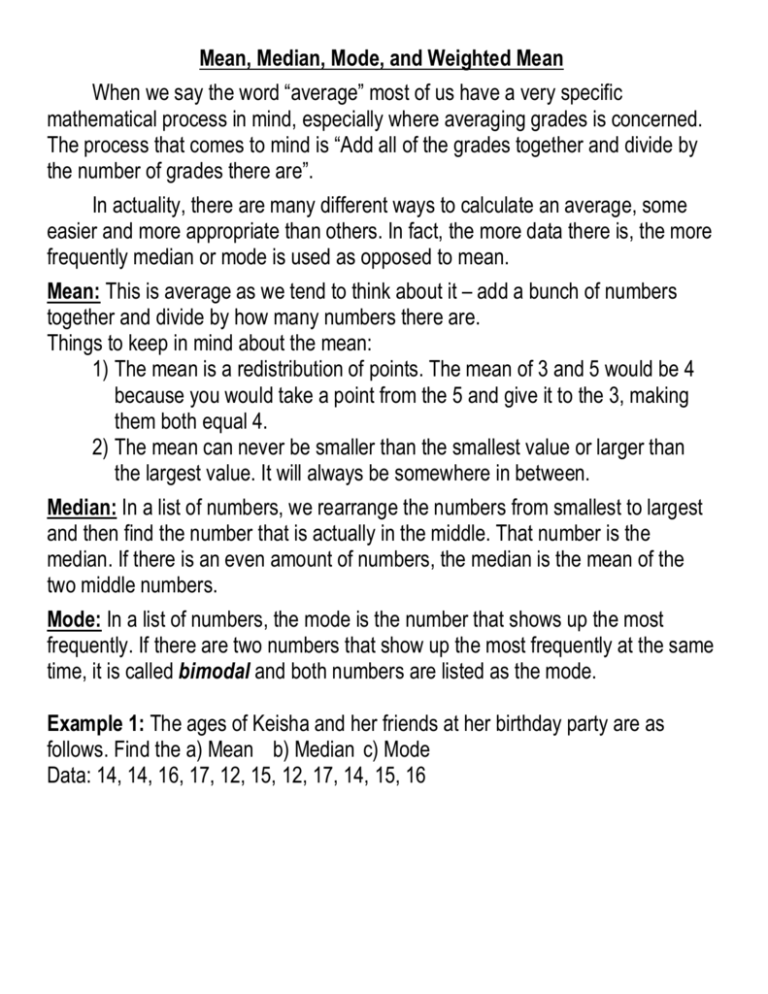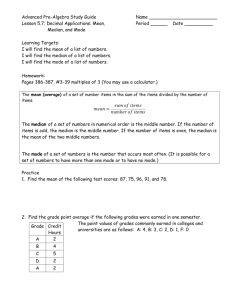Mean, Median, Mode, and Weighted Mean When we say the word
advertisement

Mean, Median, Mode, and Weighted Mean When we say the word “average” most of us have a very specific mathematical process in mind, especially where averaging grades is concerned. The process that comes to mind is “Add all of the grades together and divide by the number of grades there are”. In actuality, there are many different ways to calculate an average, some easier and more appropriate than others. In fact, the more data there is, the more frequently median or mode is used as opposed to mean. Mean: This is average as we tend to think about it – add a bunch of numbers together and divide by how many numbers there are. Things to keep in mind about the mean: 1) The mean is a redistribution of points. The mean of 3 and 5 would be 4 because you would take a point from the 5 and give it to the 3, making them both equal 4. 2) The mean can never be smaller than the smallest value or larger than the largest value. It will always be somewhere in between. Median: In a list of numbers, we rearrange the numbers from smallest to largest and then find the number that is actually in the middle. That number is the median. If there is an even amount of numbers, the median is the mean of the two middle numbers. Mode: In a list of numbers, the mode is the number that shows up the most frequently. If there are two numbers that show up the most frequently at the same time, it is called bimodal and both numbers are listed as the mode. Example 1: The ages of Keisha and her friends at her birthday party are as follows. Find the a) Mean b) Median c) Mode Data: 14, 14, 16, 17, 12, 15, 12, 17, 14, 15, 16 Example 2: Given the following grades, find the a) Mean b) Median c) Mode Data: 65, 100, 65, 95, 70, 65 (You can see why we don’t use median and mode for averaging grades!) A weighted mean is like a mean except that not everything counts the same. This happens frequently in your college classes, such as the one you’re sitting in right now: your test average counts 75% of your overall grade and your final exam counts 25% of your overall grade. Your GPA is another example of a weighted mean: higher grades result in more quality points than lower grades. Example 3: Jessie is in MAT 1012, where her test average counts 75% of her over grade and her final exam counts 25% of her overall grade. If she made 78, 85, 92, 87 on her tests and a 76 on her final exam, what is her final average in the class? Example 4: Caroline made a B in SCT 100, which is 3 credit hours; an A in English, which is 5 credit hours; and a B in Psychology, which is 5 credit hours. What was her GPA for that quarter? (An A is worth 4 points per credit hour, a B is worth 3 points per credit hour, a C is worth 2 points per credit hour, and a D is worth 1 point per credit hour.)






